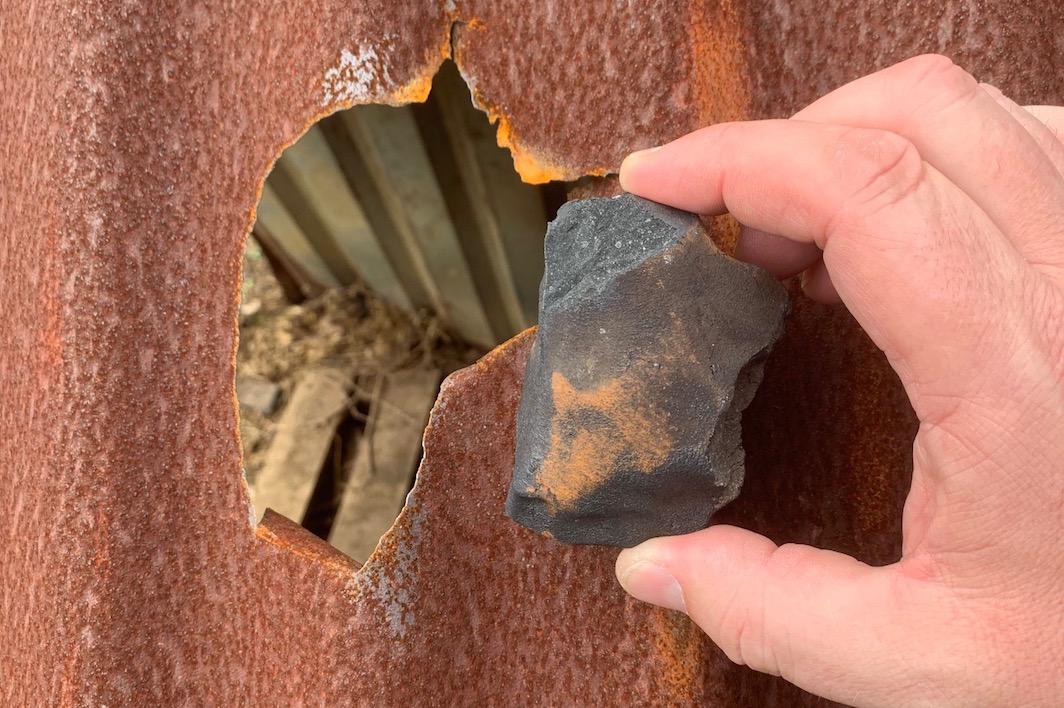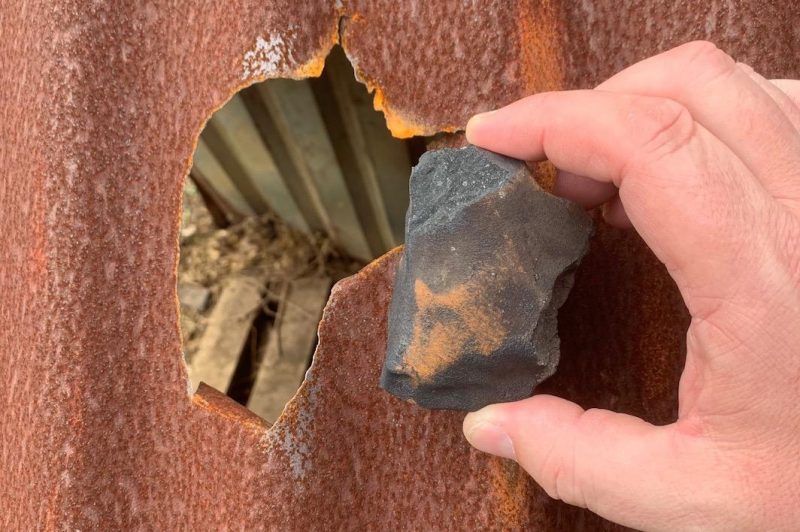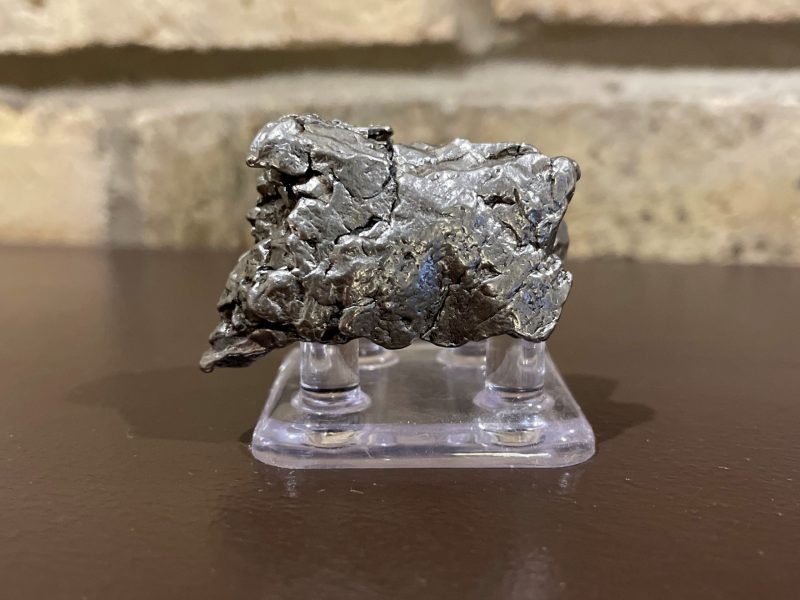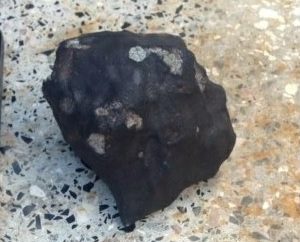

This meteorite that landed in the Aguas Zarcas district of Costa Rica hit a doghouse on April 23, 2019. The dog, Rocky, was unharmed. Note the dark fusion crust, a feature that can help you tell a meteorite from an ordinary earthly rock. Image via Arizona State University/ Michael Farmer.
Meteors are the streaks of light you see in the night sky. Most meteors are tiny particles left behind by icy comets; they never reach Earth’s surface. But sometimes chunks of more rocky or metallic space debris enter Earth’s atmosphere and survive the fiery passage to the ground. Their name changes on the first bounce off Earth’s surface from meteor to meteorite. Meteorites can turn up just about anywhere on Earth. If you’re looking for one of these space rocks, where do you look?
Some meteorites have been here on Earth for millennia, but there are continually new arrivals, some bright and loud enough to make the news. If you want to find a meteorite of your own, you can increase your odds by heading to certain types of terrain or areas where there’s been a known meteorite fall. Once you find a meteorite candidate, analyzing a few characteristics will help you determine if your rock is truly from space.
A meteorite can only get to Earth’s surface by passing through our planet’s thick atmosphere. Friction, pressure, and chemical interactions with atmospheric gases cause it to begin to burn as it plummets downward. That burning space rock is the meteor or “shooting star” you see in the sky. Its fiery entrance leaves a fusion crust on the surface of the meteorite. For this reason, meteorites tend to be darker than regular rocks on Earth, and they’re best spotted on light-colored terrain with little vegetation, such as the American Southwest or Antarctica. In fact, Antarctica is such a good spot for meteorite hunters that crews of scientists visit every year, searching for these otherworldly rocks, driving around the surface until they spot a lone dark rock on an otherwise unbroken expanse of white.
You don’t always have to travel to the other side of the world to find a meteorite. Sometimes meteorites will come to you. Keep an eye open for local reports of brilliant fireballs lighting your region’s sky. Debris from such displays scatters across the ground, and sometimes hits structures or vehicles. Keeping an eye on the websites of the American Meteor Society or the International Meteor Organization might might also be a good starting point.
Meteorite strike zones or “strewn fields” can reap rewards for years, such as the Gold Basin in Arizona, which has yielded thousands of specimens since its first discovery in 1995.

This space rock is a fragment about 2 inches (5 cm) wide, brushed to a high shine after it was collected at the Campo del Cielo site. Image via Kelly Whitt.
In 2013 after a quiet February morning was disrupted by a superbolide that lit the sky and shattered windows, residents west of Chelyabinsk in Russia found meteorites simply by looking for the holes in snowdrifts that the rocks had burrowed into. Most of us will need to work a bit harder to find our meteorites.

Fragment of the Chelyabinsk meteorite that exploded over Russia in February 2013. Image via Svend Buhl.
Just remember you’ll need permission to hike on any lands and to take out anything you find. On many areas managed by the U.S. Bureau of Land Management, whatever meteorite you find is yours to keep, with some restrictions. This FAQ tells about meteorite collection on public lands, and here’s the Bureau of Land Management policy.
When out for your next hike, look for any rock that is dissimilar to its surroundings. Meteorites are generally dark, black, or rusty and reddish brown. Some have thumbprint-like depressions covering the surface called regmaglypts.
After you find a rock you suspect is a meteorite, one of the easiest ways to check your candidate is by carrying a magnet. If the rock sticks to the magnet, you might have found a meteorite! Some meteorites have a relatively high percentage of metals, especially iron. If your budget allows, you could also use a metal detector.
If your rock has any holes, is porous or has crystals, it’s not a meteorite. To determine if you have a meteorite or a “meteor-wrong,” visit a site such as the University of New Mexico’s Meteorite Museum, which will help you analyze your rock and perform tests such as the streak test to help validate your find.

One of several stony meteorites found in Cuba on February 1, 2019, shortly after the huge meteor was seen flying across the skies. Image via Hatzel Vela (@HatzelVelaWPLG on Twitter).
Here’s a quick checklist of properties that meteorites often have:
Magnetic – A metallic meteorite will usually stick to an ordinary refrigerator magnet.
Heavy and dense – Meteorites tend to be dense, and therefore heavier than Earth rocks of the same size.
Fusion crust – When falling to Earth, the outside of the meteorite will burn and create a dark eggshell covering. If you break it open, the inside is often lighter in color.
Thumbprint depressions (regmaglypts) – Look for the shallow depressions in your rock, and compare them to images of known meteorites on the internet.
Chondrules – If you crack your rock open, it should exhibit small balls of stony material while still being densely packed and not porous.
Doesn’t streak – On the backside of a ceramic tile, write with the rock like it’s a crayon. If it leaves a mark, it’s probably from Earth. If it doesn’t leave a mark, it might be from space.
Meteorites don’t all have to have the above characteristics. Some of them may have a fusion crust and be magnetic while others have the thumbprint depressions and show chondrules when you cut them open. But if they have any of the below characteristics, they are most likely not meteorites:
Holes (or vesicles) – Terrestrial rocks can be porous and have bubbles or vesicles from their creation in magma during volcanic eruptions.
Quartz or crystals – Quartz is one of the most abundant minerals on Earth – generally not extraterrestrial.
Round or rough appearance – Meteorites tend to be very irregular shaped, but their surfaces tend to be smooth and not scratchy due to their descent through the atmosphere.
While meteorites can exist anywhere in the world, keep in mind that they are one of the rarest minerals you can find. Even gold, diamonds or emeralds are more abundant than rocks from space.
So if you find one, wow! You are lucky!
Bottom line: Meteorite hunters find terrain to hike in that is light-colored, with few plants to obscure the ground. They look for rocks that are dissimilar to their surroundings. Later, they analyze the properties of unusual rocks to see if they’ve discovered a meteorite.
Source:
https://earthsky.org/human-world/how-to-find-a-meteorite-where-to-hunt-and-identification-tips